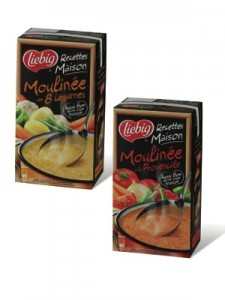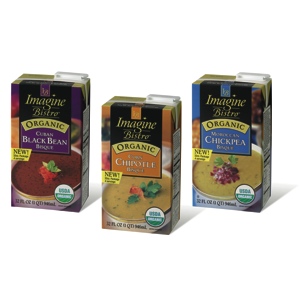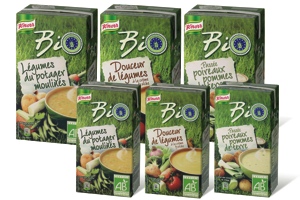
Innovations in ready-to-serve soups – potential for the carton pack
By SIG Combibloc
Food Trends Packaging Research & Development Fruit & Vegetables New products vegetablesTraditional food meets modern trend: the latest thing in your soup bowl.
Soup is an old favourite. Whether hot or cold, soups give consumers a warm glow of well-being in body and soul. This is based in part on the nostalgic charm that the be-loved old classics bring with them. Many people associate early childhood memories with sitting down at the table to eat soup freshly made by their mother or grandmother. More often nowadays, the food industry is taking on the role of domestic chef. In recent years, the market for ready-to-serve soups has shown solid growth. The market now promises strong sales potential for traditional soups in the homemade style, and for a raft of new recipes that can be tailored precisely to the consumption trends of modern consumers.
“In the food sector, health, transparency, modern lifestyle and sustainability are the four big trend topics that consumers are interested in,” says Dominik Haug, Global Market Segment manager, Food, at SIG Combibloc. “Consumers want to eat healthily and, as far as possible, they want to know exactly where the ingredients have come from and how their foods have been processed, especially if they have not prepared the food themselves, but have bought it ready to serve from the supermarket.
At the same time, the modern lifestyle has its part to play: consumers want to enjoy what they buy and, in every consumption situation, they like it to be as convenient as possible – in the preparation, and when it comes to the packaging. The issue of sus-tainable consumption is also becoming increasingly important to consumers. This is shown by the positive growth in areas such as organic and Fair Trade products.”
Appropriately positioned, premium soups in convenient packaging have good sales po-tential. In particular, the U.S., Great Britain, Canada, France and Spain (which are strong markets for ready-to-serve soups) are dynamic movers where new products are concerned. A glance at the global market for ready-to-serve soups, with many product innovations on the scene, shows clear trends in product positioning and the packaging mix as well. As the most established, traditional packaging form, the metal can is the dominant packaging solution in the soup area, but sales are stagnating. In contrast to this, ready-to-serve soups sold in handy tubular pouches, mugs and carton packs are currently flying high, with solid growth figures.
Healthy eating – natural well-being
At a time when topics relating to healthy eating have become part of the primary school curriculum, in terms of what people eat, health issues now play a bigger role than previ-ously. Against this background, a wealth of products that tap into the health trend are positioned on the market for ready-to-serve soups. These soup varieties emphasize qualities such as selecting only natural ingredients, or they may be based on “free from” concepts, with recipes featuring no salt or no flavour enhancers, or with reduced fat, having a beneficial effect on consumers’ physical well-being.
For example, Mexican soups from Rosa Mexicano Kitchen, selling in the U.S. under the tagline “all natural,” are specifically positioned as natural. Mexican cuisine is extremely popular in the U.S., and is well known for the abundance of unusual ingredients and spices that are needed to create the characteristic piquant dishes. The Rosa Mexicano brand stands for authentic Mexican cuisine and the use of natural, original Mexican in-gredients. The Rosa Mexicano all-natural range is available in Mexican Chicken Broth, Cream of Tomato-Chipotle Soup, and Aztec Tortilla Soup varieties.
In France, SILL is also going for naturalness and authenticity, with its “Nature” range selling under the La Potagère brand name. These sophisticated specialty soups are made exclusively from natural ingredients, including 70 per cent vegetables. The com-pany is committed to producing healthy food, and its ready-to-serve soup range con-tains no artificial flavouring, also scoring with health-conscious consumers thanks to a reduced salt content.
Transparency – the informed consumer
“The boundaries between the major product trends sometimes blend and blur,” says Haug. For instance, for consumers, health aspects are very often linked to having as much transparency as possible in relation to the source of the ingredients, and with re-spect to the processing methods and recipes used.” Natural purity and authenticity are the order of the day for consumers, and products that come from the local area and that are grown and processed according to traditional methods enjoy a high level of trust. “Localness” and naturalness relate to the source of the ingredients, and to the recipes used.
 In line with this particular trend, under the Liebig Recette Maison brand, Campbell France is offering a vegetable and Provençale sieved soup, both made using the finest, 100-per-cent natural ingredients. The soups are processed with no colourants and no preservatives, and the same ingredients than those used for homemade soups.
In line with this particular trend, under the Liebig Recette Maison brand, Campbell France is offering a vegetable and Provençale sieved soup, both made using the finest, 100-per-cent natural ingredients. The soups are processed with no colourants and no preservatives, and the same ingredients than those used for homemade soups.
Modern lifestyle – the easy way to enjoy
The modern lifestyle embraces enjoyment and convenience in equal measure. To enjoy high-quality meals perfectly tailored to the diner’s taste preferences, these days nobody needs to spend valuable time searching for the right ingredients, and hours standing over the stove.
With the Knorr Les Moments Gourmets range, for instance, Unilever is selling premium soups in France that offer exquisite taste sensations made to gourmet recipes. Whether it is Lobster and Scampi Bisque with White Wine, Vegetable Soup with Beaufort Cheese and Chestnut – or perhaps a smooth Onion Fondue and Duck Confit with Honey and Spices – these select soup varieties call to mind the potage assortment in a gourmet re-staurant, and are offered ready-made and flavoured to perfection in aseptic carton packs.
“Here, flavour and practical finesse are a winning combination,” says Haug. “Ready-to-serve UHT soup creations save time and are hugely convenient, as they need only be heated up before eating. One of the other advantages of soups packaged aseptically in carton packs is that they can be stored without refrigeration for a prolonged period, with no impairment of their quality. Thanks to the composite structure of the carton pack, the product is securely protected. The packaging component of a carton pack is composed primarily of unprocessed paperboard and polymers. At up to 75 per cent, cardboard is the main component, and gives the carton pack stability. The inner polymer layers form a liquid barrier for the food, while the outer layer keeps moisture out. Usually, a wafer-thin layer of aluminium is added. This layer safeguards the contents against light, oxy-gen and external odours.”
As well as the protection of the food afforded by the specific properties of the compos-ite, for the market expert the special feature of the filling technology from SIG Combi-bloc is its product flexibility, from which ultimately the consumer also benefits. Not only liquid, but also pasty and chunky soups can be filled easily. “The modern, health-conscious consumer likes the food to be as natural and unprocessed as possible,” says Haug. “The special composite structure of the carton pack and the aseptic process lend themselves particularly well to this, because in the aseptic process that is used to pas-teurize soups before they are filled into the carton packs, the products are rapidly heated to ultra-high temperature, immediately cooled again and then filled into sterile carton packs.
The thermal process is carried out very rapidly, so that nothing is cooked – instead, the flavour, aromas, nutrients and vitamins in the  foods are retained. This comes through clearly in the quality of the taste. As each carton pack is individually shaped inside our filling machines, sealed across the base, and the food is filled into the open top of the carton, this means liquid broths and pasty and chunky soups can all be filled into our carton packs easily and safely. Consumers like a certain particulate content in their soup, because many tend to feel that larger pieces of vegetables suggest a product that is natural, not over-processed, and is healthy and rich in fibre. An obvious particulate content in a soup is also in line with the trend towards soup increasingly being eaten as a meal in its own right, and no longer just as a starter.”
foods are retained. This comes through clearly in the quality of the taste. As each carton pack is individually shaped inside our filling machines, sealed across the base, and the food is filled into the open top of the carton, this means liquid broths and pasty and chunky soups can all be filled into our carton packs easily and safely. Consumers like a certain particulate content in their soup, because many tend to feel that larger pieces of vegetables suggest a product that is natural, not over-processed, and is healthy and rich in fibre. An obvious particulate content in a soup is also in line with the trend towards soup increasingly being eaten as a meal in its own right, and no longer just as a starter.”
Sustainable consumption – responsibility for people and environment
Alongside health, transparency and enjoyment, for modern consumers the issue of sus-tainable consumption is playing an even greater role in their choices. And against this background, it is not just the ‘organic’ business that is booming. In addition to products that have been organically grown, more and more often purchase decisions are also in-fluenced by considerations relating to protecting the environment, and to ethical princi-ples.
Imagine Bistro Organic is a range of soups for the U.S. market that is being filled in aseptic carton packs by Foodswing. The packaging carries the USDA Organic label. This guarantees that the national, mandatory standards for organically produced agri-cultural products developed by the U.S. Department of Agriculture are complied with. Products displaying this label originate from farms or businesses approved in accor-dance with these standards for organic cultivation and processing.
Similarly, in France, Knorr has an organic range of ready-to-serve soups labelled with the French national AB logo denoting organic cultivation, and with the European Bio logo for organic products. This range is aimed primarily at “eco-citizens” – those indi-viduals who in their everyday life strive to think and act in an environmentally sound manner. It is estimated that in France this group already numbers around four million households.
 In Spain, Gallina Blanca packages a soup range in carton packs displaying an FSC la-bel. The label of the Forest Stewardship Council (FSC) is internationally acknowledged as one of the most recognized and most widely accepted verifications that the wood fi-bres used to manufacture a product can be proven to originate from forests that are managed responsibly and to the highest standards and certified according to FSC guidelines, or from other controlled sources. The FSC is an international, independent, non-profit organization committed to promoting a worldwide binding scheme for the re-sponsible and exemplary management of forest resources. For this, the FSC issues cer-tificates for wood and timber products originating from socially and environmentally re-sponsible forestry.
In Spain, Gallina Blanca packages a soup range in carton packs displaying an FSC la-bel. The label of the Forest Stewardship Council (FSC) is internationally acknowledged as one of the most recognized and most widely accepted verifications that the wood fi-bres used to manufacture a product can be proven to originate from forests that are managed responsibly and to the highest standards and certified according to FSC guidelines, or from other controlled sources. The FSC is an international, independent, non-profit organization committed to promoting a worldwide binding scheme for the re-sponsible and exemplary management of forest resources. For this, the FSC issues cer-tificates for wood and timber products originating from socially and environmentally re-sponsible forestry.
“Effective measures for protecting the environment are increasingly playing a key role not just for the food industry and the retail market, but also for consumers,” says Haug. The FSC logo on the carton packs shows an exemplary environmental commitment. It confirms that all the wood fibres used to manufacture the packaging, along the entire value-added chain – from the labelled carton pack right back to the forest of origin – can be traced back to their source in accordance with the FSC standards. It also shows that the wood fibres processed to manufacture the packaging were sourced from FSC-certified or other controlled forests. This provides demonstrable proof that wood from il-legal sources, ruthlessly over-cultivated forests or sources that cannot be verified, is avoided.”
Good prospects for the carton pack
For Haug, global consumer trends, in combination with the existing vitality in the market for ready-to-serve soups, are the crucial factors pointing towards strong growth fore-casts for soups offered in carton packs. “For many areas, such as the U.S., France, Spain and Canada, we’re estimating a growth rate of up to eight per cent a year for car-ton packs,” he says.
SIG Combibloc is one of the world’s leading system suppliers of carton packaging and filling machines for beverages and food. In 2010 the company achieved a turnover of 1,360 million Euros, with approximately 4,650 employees in 40 countries. SIG Combi-bloc is part of the New Zealand-based Rank Group.
Print this page